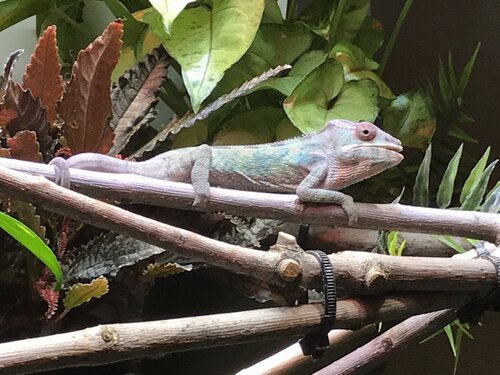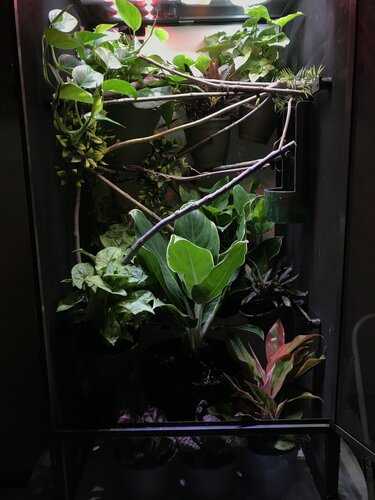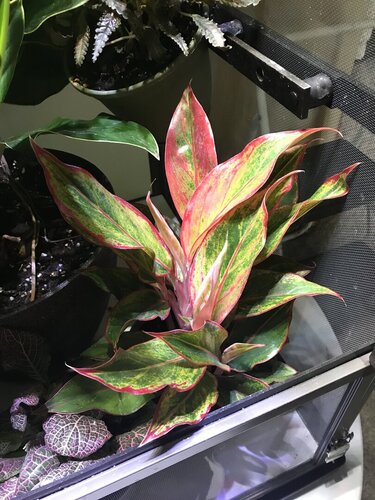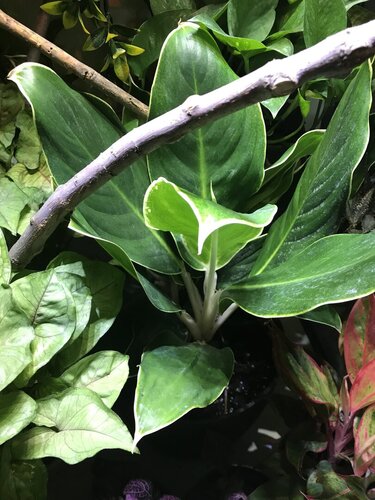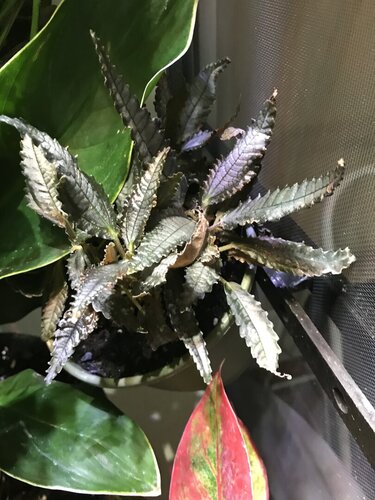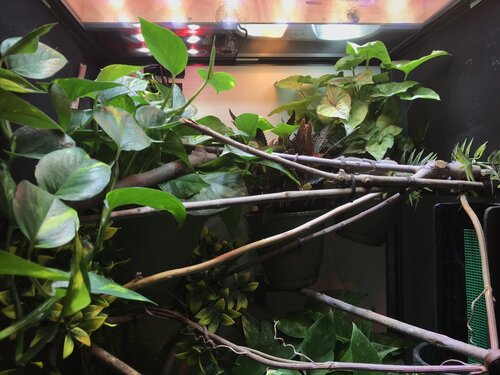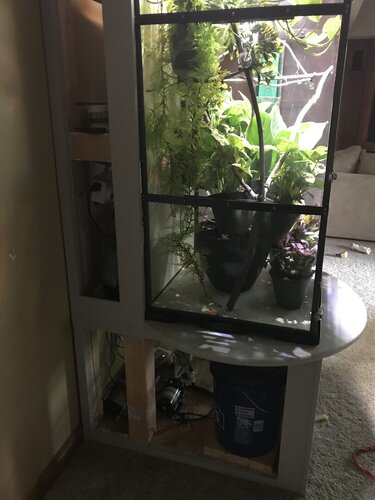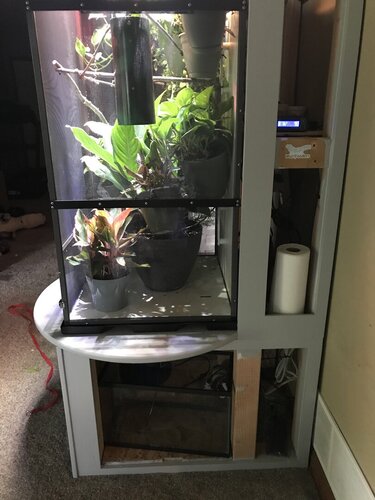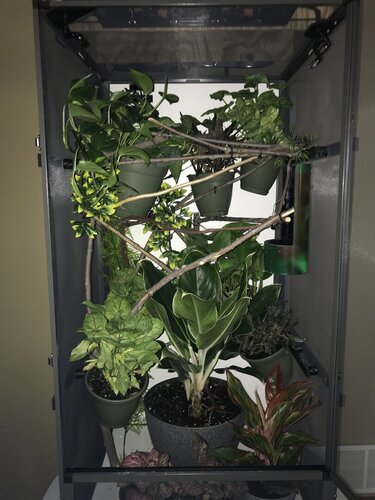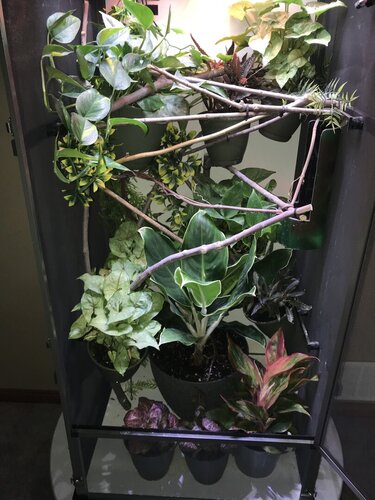DocZ
Chameleon Enthusiast
During the Coronavirus shelter in place, our home zoo has grown significantly. My son got a leopard gecko Larry which reignited my desire to get a chameleon. I had a Senegal chameleon about 20 plus years ago. Unfortunately, likely due to my inadequate care, he only lived a few months. So I decided it was time to get another chameleon. Calcifer arrived one month ago and is settling in nicely. I filled out a care sheet and would appreciate any advice you all can give me. Thanks
Corey
Chameleon Info:
Corey
Chameleon Info:
- Your Chameleon - The species, sex, and age of your chameleon. How long has it been in your care?
Calcifer is a 4 month-old, male Amilobe panther chameleon, and he’s been with us for about one month. - Handling - How often do you handle your chameleon?
He and I are definitely not friends right nowI do not hold him at all if it can be avoided
- Feeding - What are you feeding your cham? What amount? What is the schedule? How are you gut-loading your feeders?
He’s eating some combination of BSFL, crickets, dubias, discoids, silkworms, and an occasional superworms and the rare mealworm (bought those before I learned more about lizard nutrition) He eats daily, probably about 6-8 items between a couple of feedings. He tong feeds or controlled free range, doesn’t like to use feeder run. I’m gut loading with dandelion greens, carrots, bell peppers, Josh’s frogs cricket feed, Joe’s Bugz roach feed, and I dust the gut load veggies/feed with Zoo med repticalcium with D3, Rep-cal multivitamin, spirulina powder, chlorella powder, and a little bee pollen - Supplements - What brand and type of calcium and vitamin products are you dusting your feeders with and what is the schedule?
Calcifer gets Zoomed calcium without D3 6 days a week and 7th day alternates rep-cal calcium with D3 and rep-cal multivitamin - Watering - What kind of watering technique do you use? How often and how long to you mist? Do you see your chameleon drinking?
have a mist king ultimate with one double nozzle and one single nozzle. It runs at 0658 for 2 minutes, 2000 for 2 minutes, 2200 for one minute, 0100 for one minute, and 0430 for one minute. I saw him drinking more when we first got him, but pretty rarely now. I also run a fogger at night that is controlled by a Herpstat 2. Its set to run for about 5 minutes or when it reaches 90% humidity 9 times a night between 0100 and 0500 - Fecal Description - Briefly note colors and consistency from recent droppings. Has this chameleon ever been tested for parasites?
Stool is firm and brown with bright white urates. He’s never been tested for parasites - History - Any previous information about your cham that might be useful to others when trying to help you.
I purchased him from Roberson reptiles. His sire is a beautiful Amilobe named Nixon
- Cage Type - Describe your cage (Glass, Screen, Combo?) What are the dimensions?
Calcifer lives in a 2x2x4 Dragon Strand screen on sides, front, and top. - Lighting - What brand, model, and types of lighting are you using? What is your daily lighting schedule? I have several lights on his cage. I have a Zoomed dual dome with a 100w basking bulb and 5% mini compact fluorescent UVB. I have a Reptisun UVB/LED fixture with 3 LED modules and a 24” 5% T5 UVB. There are also two other reptisun LED fixtures one with 2 LED modules and one with a single. I was concerned about having enough light for the plants and didn’t want to replace fluorescent bulbs all the time. The Herpstat 2 ramps up the basking bulb from 0700 to 0800 when all of the LED/UVBs come on, and it ramps down the basking bulb from 1900 to 2000 when all the lights go off. I purchased a Solarmeter 6.5 and adjusted the height of his two UVB bulbs so it reads about 6.5-7 at the cage ceiling and about 2-3 at his branches.
- Temperature - What temp range have you created (cage floor to basking spot)? Lowest overnight temp? How do you measure these temps?
His basking spot is regulated to 86 with the Herpstat (it was 85 and he kept basking on the ceiling, one degree up seems to have cured this. I hate it when gets on the ceiling). A digital thermometer/hygrometer in the back about 24 inches down from the ceiling usually reads about 73-75 when his basking lamp is on. Lowest overnight temp is about 63-65 - Humidity - What are your humidity levels? How are you creating and maintaining these levels? What do you use to measure humidity? Daytime humidity is about 40-50% the hygrometer usually shows highs of 90% from overnight which is when the fogger and the mistking run mostly.
- Plants - Are you using live plants? If so, what kind?
I have mostly live plants with 11 potted plants in his enclosure. 2 pothos, 2 piles, (can’t remember the others, I’ll get some pictures). There are a couple of plastics to cover some ugly spots (lots of zip ties, sticks coming together, or covering probe wires) and one that conceals one of his main travel vines to the lower part of his cage which hopefully make him feel more secure. - Placement - Where is your cage located? Is it near any fans, air vents, or high traffic areas? At what height is the top of the cage relative to your room floor?
The cage is in our basement which is always cooler than the rest of the house. I closed the vents closest to it. I built a stand for his cage which makes it stand a little over 6 feet tall at the ceiling. - Location - Where are you geographically located?
I’m located in Omaha, NE
- Humidity is hard to regulate. I turned up his Herpstat hygrostat to 95% today. With air conditioning running in the summer, humidity is difficult to keep up any higher. I’m considering adding some clear acrylic outside the cage to keep humidity up. It’s a big open room, so humidifying the whole room isn’t realistic. I probably should have gotten a cage with at least solid sides
- I’ve read to gut-load insects 12-24 hours before feeding. I feed the gut load mix every day not just before I feed the bugs. What do people feed their insects daily instead of the gut load?
- Having trouble uploading pictures right now. I’ll do some resizing and post some shortly


